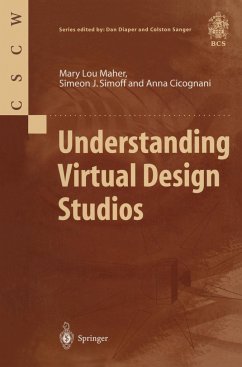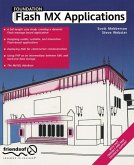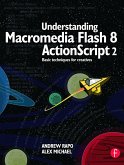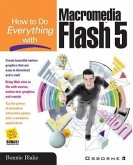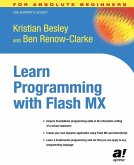- Broschiertes Buch
- Merkliste
- Auf die Merkliste
- Bewerten Bewerten
- Teilen
- Produkt teilen
- Produkterinnerung
- Produkterinnerung
This volume examines the issues involved in setting up and running a virtual design studio. It presents an interdisciplinary framework for organizing, running, and improving virtual design studios. Technological issues are presented in a practical context, showing how to realize each aspect of the studio. The authors also assess potential benefits, such as improved creativity and collaboration, and other areas in which our understanding needs to be furthered. Relevant software will be available on the authors website.
Andere Kunden interessierten sich auch für
![Communicating the UX Vision Communicating the UX Vision]() Martina SchellCommunicating the UX Vision47,99 €
Martina SchellCommunicating the UX Vision47,99 €![Foundation Flash MX Applications Foundation Flash MX Applications]() Scott MebbersonFoundation Flash MX Applications22,99 €
Scott MebbersonFoundation Flash MX Applications22,99 €![Understanding Macromedia Flash 8 ActionScript 2 Understanding Macromedia Flash 8 ActionScript 2]() Andrew RapoUnderstanding Macromedia Flash 8 ActionScript 244,99 €
Andrew RapoUnderstanding Macromedia Flash 8 ActionScript 244,99 €![Foundation ActionScript for Flash 8 Foundation ActionScript for Flash 8]() Kristian BesleyFoundation ActionScript for Flash 838,99 €
Kristian BesleyFoundation ActionScript for Flash 838,99 €![How to Do Everything with Macromedia Flash 5 How to Do Everything with Macromedia Flash 5]() How to Do Everything with Macromedia Flash 526,99 €
How to Do Everything with Macromedia Flash 526,99 €![Learn Programming with Flash MX Learn Programming with Flash MX]() Ben Renow-ClarkeLearn Programming with Flash MX34,99 €
Ben Renow-ClarkeLearn Programming with Flash MX34,99 €![Automatic Speech Recognition on Mobile Devices and Over Communication Networks Automatic Speech Recognition on Mobile Devices and Over Communication Networks]() Zheng-Hua Tan / Børge Lindberg (eds.)Automatic Speech Recognition on Mobile Devices and Over Communication Networks117,99 €
Zheng-Hua Tan / Børge Lindberg (eds.)Automatic Speech Recognition on Mobile Devices and Over Communication Networks117,99 €-
-
-
This volume examines the issues involved in setting up and running a virtual design studio. It presents an interdisciplinary framework for organizing, running, and improving virtual design studios. Technological issues are presented in a practical context, showing how to realize each aspect of the studio. The authors also assess potential benefits, such as improved creativity and collaboration, and other areas in which our understanding needs to be furthered. Relevant software will be available on the authors website.
Hinweis: Dieser Artikel kann nur an eine deutsche Lieferadresse ausgeliefert werden.
Hinweis: Dieser Artikel kann nur an eine deutsche Lieferadresse ausgeliefert werden.
Produktdetails
- Produktdetails
- Computer Supported Cooperative Work (CSCW)
- Verlag: Springer, Berlin
- 1st ed.
- Seitenzahl: 236
- Erscheinungstermin: 8. November 1999
- Englisch
- Abmessung: 235mm x 155mm x 16mm
- Gewicht: 474g
- ISBN-13: 9781852331542
- ISBN-10: 1852331542
- Artikelnr.: 22215532
- Herstellerkennzeichnung
- Libri GmbH
- Europaallee 1
- 36244 Bad Hersfeld
- gpsr@libri.de
- Computer Supported Cooperative Work (CSCW)
- Verlag: Springer, Berlin
- 1st ed.
- Seitenzahl: 236
- Erscheinungstermin: 8. November 1999
- Englisch
- Abmessung: 235mm x 155mm x 16mm
- Gewicht: 474g
- ISBN-13: 9781852331542
- ISBN-10: 1852331542
- Artikelnr.: 22215532
- Herstellerkennzeichnung
- Libri GmbH
- Europaallee 1
- 36244 Bad Hersfeld
- gpsr@libri.de
One: Basic Concepts.- One: The Concept of A Virtual Design Studio.- 1.1 Scenario.- 1.2 Experiences.- 1.3 Observations.- 1.4 Directions.- References.- Two: Network Technology.- 2.1 TCP/IP Communication.- 2.2 The Internet.- 2.3 The World Wide Web.- 2.4 Implications.- References.- Three: Digital Design Media.- 3.1 Images.- 3.2 CAD and 3D Models.- 3.3 Text.- 3.4 Hypermedia.- 3.5 Summary.- References.- Two: Communication and Representation.- Four: Communication in a Virtual Environment.- 4.1 Computer Mediated Communication.- 4.2 Communication Tools.- 4.2.1 Asynchronous Tools: Email, List Servers, Bulletin Boards.- Email.- List Servers.- Bulletin Boards.- 4.2.2 Synchronous Tools: Chat, Video Conference, Broadcast.- IRC, ICQ and Chatting Systems.- Video Conference.- Broadcast.- 4.3 Virtual Worlds.- 4.3.1 Communication in a Text-Based VW.- 4.3.2 Navigation in Text-Based VW.- 4.3.3 Actions in a Text-Based VW.- 4.4 Use Of Communication Tools in a VDS.- 4.4.1 Effective Use Of Communication Tools in a VDS.- 4.4.2 Alternative Communication Channels.- 4.5 Summary.- References.- Five: Shared Representation in a Vds.- 5.1. The Roles of Shared Representation.- 5.2. Structuring Shared Representations as Hypermedia.- 5.2.1 Structural Consistency.- 5.2.2 Labels And Information Retrieval.- 5.2.3 Dynamic Versus Static Linking.- 5.3 The Content of Shared Representation.- 5.3.1 Activity/Space Ontology.- 5.3.2 Function/Behaviour/Structure Ontology.- 5.4 Shared Representation - Ontology and Hypermedia.- References.- Three: The Shared Environment.- Six: The Distributed Design Studio.- 6.1 Loosely Coupled Desktop.- 6.1.1 Integration Agreements and Interface Design.- 6.1.2 Management and Collaboration.- 6.1.3 Communication and Collaboration.- 6.1.4 Handling Project Information, Library Support and Documentation.- 6.1.5 Diversity and Discontinuity in Loosely Coupled VDS.- 6.2 The Tightly Integrated VDS Desktop.- 6.2.1 Integration Agreements and Interface Design.- 6.2.2 Management and Collaboration.- 6.2.3 Communication and Collaboration.- 6.2.4 Handling Project Information, Library Support and Documentation.- 6.2.5 Customisation and Further Automation in a Tightly Integrated VDS.- 6.3 Recapitulation.- References.- Seven: A Centralised VDS Environment.- 7.1 The Desktop Metaphor.- 7.1.1 Habanera.- 7.1.2 TeamWave.- 7.2 The Place Metaphor.- 7.2.2 Virtual Realities.- Colony City.- Activeworlds.- The Cave Environment.- 7.2.3 Virtual Worlds.- StudioMOO.- 7.3 Beyond Metaphors.- References.- Epilogue.- Appendix: Web Resources.- A.1 General Information for Virtual Design Studios.- A.2 Communication Resources.- A.3 Virtual Worlds.- Author Information.
One: Basic Concepts.- One: The Concept of A Virtual Design Studio.- 1.1 Scenario.- 1.2 Experiences.- 1.3 Observations.- 1.4 Directions.- References.- Two: Network Technology.- 2.1 TCP/IP Communication.- 2.2 The Internet.- 2.3 The World Wide Web.- 2.4 Implications.- References.- Three: Digital Design Media.- 3.1 Images.- 3.2 CAD and 3D Models.- 3.3 Text.- 3.4 Hypermedia.- 3.5 Summary.- References.- Two: Communication and Representation.- Four: Communication in a Virtual Environment.- 4.1 Computer Mediated Communication.- 4.2 Communication Tools.- 4.2.1 Asynchronous Tools: Email, List Servers, Bulletin Boards.- Email.- List Servers.- Bulletin Boards.- 4.2.2 Synchronous Tools: Chat, Video Conference, Broadcast.- IRC, ICQ and Chatting Systems.- Video Conference.- Broadcast.- 4.3 Virtual Worlds.- 4.3.1 Communication in a Text-Based VW.- 4.3.2 Navigation in Text-Based VW.- 4.3.3 Actions in a Text-Based VW.- 4.4 Use Of Communication Tools in a VDS.- 4.4.1 Effective Use Of Communication Tools in a VDS.- 4.4.2 Alternative Communication Channels.- 4.5 Summary.- References.- Five: Shared Representation in a Vds.- 5.1. The Roles of Shared Representation.- 5.2. Structuring Shared Representations as Hypermedia.- 5.2.1 Structural Consistency.- 5.2.2 Labels And Information Retrieval.- 5.2.3 Dynamic Versus Static Linking.- 5.3 The Content of Shared Representation.- 5.3.1 Activity/Space Ontology.- 5.3.2 Function/Behaviour/Structure Ontology.- 5.4 Shared Representation - Ontology and Hypermedia.- References.- Three: The Shared Environment.- Six: The Distributed Design Studio.- 6.1 Loosely Coupled Desktop.- 6.1.1 Integration Agreements and Interface Design.- 6.1.2 Management and Collaboration.- 6.1.3 Communication and Collaboration.- 6.1.4 Handling Project Information, Library Support and Documentation.- 6.1.5 Diversity and Discontinuity in Loosely Coupled VDS.- 6.2 The Tightly Integrated VDS Desktop.- 6.2.1 Integration Agreements and Interface Design.- 6.2.2 Management and Collaboration.- 6.2.3 Communication and Collaboration.- 6.2.4 Handling Project Information, Library Support and Documentation.- 6.2.5 Customisation and Further Automation in a Tightly Integrated VDS.- 6.3 Recapitulation.- References.- Seven: A Centralised VDS Environment.- 7.1 The Desktop Metaphor.- 7.1.1 Habanera.- 7.1.2 TeamWave.- 7.2 The Place Metaphor.- 7.2.2 Virtual Realities.- Colony City.- Activeworlds.- The Cave Environment.- 7.2.3 Virtual Worlds.- StudioMOO.- 7.3 Beyond Metaphors.- References.- Epilogue.- Appendix: Web Resources.- A.1 General Information for Virtual Design Studios.- A.2 Communication Resources.- A.3 Virtual Worlds.- Author Information.

